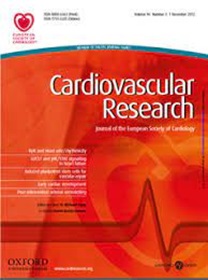Targeting the PDK/PDH axis modulates neutrophil and smooth muscle cell pathological responses and prevents abdominal aortic aneurysm formation
IF 10.2
1区 医学
Q1 CARDIAC & CARDIOVASCULAR SYSTEMS
引用次数: 0
Abstract
Aims Abdominal aortic aneurysm (AAA) is a life-threatening condition where inflammation plays a key role. Currently, AAA treatment relies exclusively on surgical interventions, and no guideline drug therapy to prevent aneurysm growth or rupture is available. Pharmacological reprogramming of immune cell metabolism, through the modulation of the pyruvate dehydrogenase kinase/pyruvate dehydrogenase (PDK/PDH) axis, has been identified as an attractive strategy to combat inflammation. Here we aimed, for the first time, to investigate the role of the PDK/PDH axis in AAA and its potential as a therapeutic target. Methods and results Analysis of three separate transcriptome datasets revealed that the expression of PDK isoenzymes is skewed in human AAA. Thus, human AAA homogenates showed increased levels of phosphorylated PDH-Ser293 and lactate compared to controls, confirming a metabolic deviation. In mice subjected to porcine pancreatic elastase (PPE)-induced AAA, treatment with dichloroacetate (DCA), a pan inhibitor of PDK isoenzymes, prevented aortic dilation, reducing the increase in inner aortic diameter by approximately 58% compared to controls. Further analysis showed that DCA treatment upregulated contractile VSMC-related genes and downregulated neutrophil-related genes in the mice. In line with the previous, PDK-inhibition prevented elastin breakdown, preserved aortic alpha-smooth muscle actin and collagen expression, and decreased neutrophil infiltration and neutrophil extracellular traps (NET) release. Thus, treating VSMC with DCA or PDK1-siRNA revealed that the PDK/PDH axis regulates their dedifferentiation, influencing contractile gene expression and proliferation. Moreover, we found that DCA-induced PDK inhibition inhibited neutrophil NET release in vivo and in vitro. Conclusion We show that the PDK/PDH axis is skewed in human AAA. Through the inhibition of PDK, in vitro and in vivo, we demonstrated that the PDK/PDH axis is a key regulator of vascular- and neutrophil-associated pathological responses with AAA formation. Our study pinpoints immunometabolic reprogramming using PDK inhibitors as an attractive strategy to fight AAA disease.求助全文
约1分钟内获得全文
求助全文
来源期刊

Cardiovascular Research
医学-心血管系统
CiteScore
21.50
自引率
3.70%
发文量
547
审稿时长
1 months
期刊介绍:
Cardiovascular Research
Journal Overview:
International journal of the European Society of Cardiology
Focuses on basic and translational research in cardiology and cardiovascular biology
Aims to enhance insight into cardiovascular disease mechanisms and innovation prospects
Submission Criteria:
Welcomes papers covering molecular, sub-cellular, cellular, organ, and organism levels
Accepts clinical proof-of-concept and translational studies
Manuscripts expected to provide significant contribution to cardiovascular biology and diseases
 求助内容:
求助内容: 应助结果提醒方式:
应助结果提醒方式:


